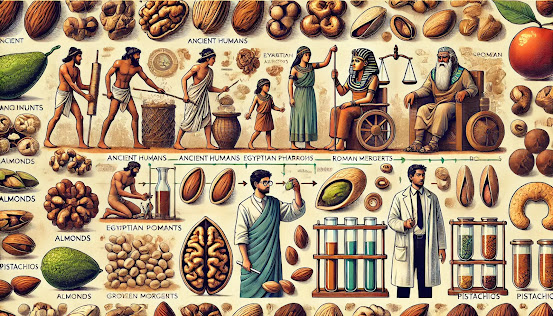Introduction
Nuts have been a vital part of the human diet for thousands of years, long before modern agriculture and supermarkets. But have you ever wondered when and how our ancestors first discovered these tiny, nutrient-packed superfoods? From prehistoric hunter-gatherers to ancient empires, nuts have played an essential role in human survival, trade, and even mythology. Let’s travel back in time and uncover the fascinating story of how nuts became a global dietary staple!
The First Encounter: Nuts in Prehistoric Times
Archaeological evidence suggests that humans have been consuming nuts for over 780,000 years! Excavations in Israel’s Gesher Benot Ya’aqov site revealed burnt remnants of wild almonds, pistachios, water chestnuts, and acorns, proving that early humans not only ate nuts but also cooked them.
Back then, people relied on gathering whatever nature provided, and nuts were an easy, energy-rich food source. Unlike fresh fruits or meats that spoiled quickly, nuts could be stored for long periods, making them essential during harsh winters and food shortages.
Imagine a group of early humans stumbling upon a wild almond tree. At first, they might have hesitated—some wild nuts contained toxins. But through trial and error, they learned which ones were safe to eat and even discovered that roasting or soaking could remove bitterness and toxins. This simple yet groundbreaking discovery paved the way for nuts to become a key survival food.
Nuts in Ancient Civilizations: A Symbol of Wealth and Health
As human societies evolved, nuts gained more than just nutritional value—they became symbols of wealth, trade, and even religious offerings.
1. Ancient Egypt: The Nut-Loving Pharaohs
The Egyptians were among the first civilizations to cultivate and trade nuts. They prized almonds, walnuts, and pine nuts, often including them in tombs to accompany pharaohs into the afterlife.
Egyptian scrolls and murals depict nuts as a crucial food source, used in breads, oils, and medicinal treatments. The famous tomb of King Tutankhamun (1323 BCE) contained jars of almonds, proving their significance in both daily life and royal ceremonies.
2. Ancient Greece and Rome: The First Nut “Superfans”
Greek scholars like Hippocrates and Galen praised nuts for their medicinal properties, believing they could cure ailments and boost intelligence. Meanwhile, the Romans took it a step further, using walnuts in wedding rituals as a symbol of prosperity and fertility.
The Romans also popularized pistachios and hazelnuts, carrying them across Europe and planting nut trees along their trade routes. Thanks to their conquests, nuts spread far beyond the Mediterranean, reaching modern-day England, Germany, and even parts of Asia.
3. China and the East: Nuts as Medicine
Ancient Chinese texts dating back to 2000 BCE describe walnuts and almonds as essential foods in traditional medicine. These nuts were believed to promote brain health, improve digestion, and even increase longevity.
The Chinese were also among the first to cultivate peanuts, which, despite their name, are legumes rather than tree nuts. Over time, peanuts became a major staple in Asian cuisine, leading to the development of peanut oil, peanut sauces, and snacks that remain popular today.
The Role of Nuts in Trade and Exploration
As trade routes expanded, nuts became valuable commodities. Merchants traveling along the Silk Road and the Spice Routes carried almonds, cashews, and pistachios across continents, introducing them to new cultures and cuisines.
By the 15th and 16th centuries, European explorers like Christopher Columbus and Vasco da Gama brought nuts to the Americas. Spanish settlers introduced almonds and walnuts to California, while Portuguese traders carried cashews to Brazil, where they thrived in the tropical climate.
Thanks to globalization, nuts became a household staple worldwide, used in everything from desserts (think baklava and marzipan) to savory dishes (like peanut stews and nut-crusted meats).
Nuts in Modern Science: More Than Just a Snack
Today, nuts are celebrated as one of the most nutrient-dense foods available. Scientific research confirms what ancient civilizations already knew—nuts offer incredible health benefits, including:
✅ Heart health: Nuts like walnuts and almonds help lower bad cholesterol (LDL) and boost heart function. ✅ Brain power: Omega-3-rich nuts (especially walnuts) improve cognitive function and memory. ✅ Weight management: Despite their calorie content, nuts promote fullness and prevent overeating. ✅ Diabetes control: Studies show that nuts can stabilize blood sugar levels and reduce the risk of type 2 diabetes. ✅ Longevity: People who regularly eat nuts tend to live longer, healthier lives.
Fun Facts About Nuts You Probably Didn’t Know
🔹 Walnuts look like brains—and science shows they actually support brain function! 🔹 Pistachios glow under UV light due to their natural chlorophyll content. 🔹 Almonds aren’t true nuts—they’re seeds from the almond tree’s fruit. 🔹 Cashews grow on the bottom of cashew apples and must be roasted to remove toxic shells. 🔹 Peanuts are the most consumed nut worldwide—even though they’re technically legumes!
Conclusion: A Timeless Superfood
From ancient survival food to modern-day superfood, nuts have stood the test of time. Their journey—from being foraged by prehistoric humans to becoming a global industry worth billions—is nothing short of remarkable.
Whether you enjoy them roasted, raw, or blended into nut butters, nuts are more than just a tasty snack—they’re a link to our ancestors, a symbol of health, and a testament to human ingenuity.
So, the next time you munch on a handful of almonds or walnuts, take a moment to appreciate the thousands of years of history behind these incredible little powerhouses!


Comments
Post a Comment